check engine MERCEDES-BENZ GL 2012 Owners Manual
[x] Cancel search | Manufacturer: MERCEDES-BENZ, Model Year: 2012, Model line: GL, Model: MERCEDES-BENZ GL 2012Pages: 384, PDF Size: 15.71 MB
Page 9 of 384
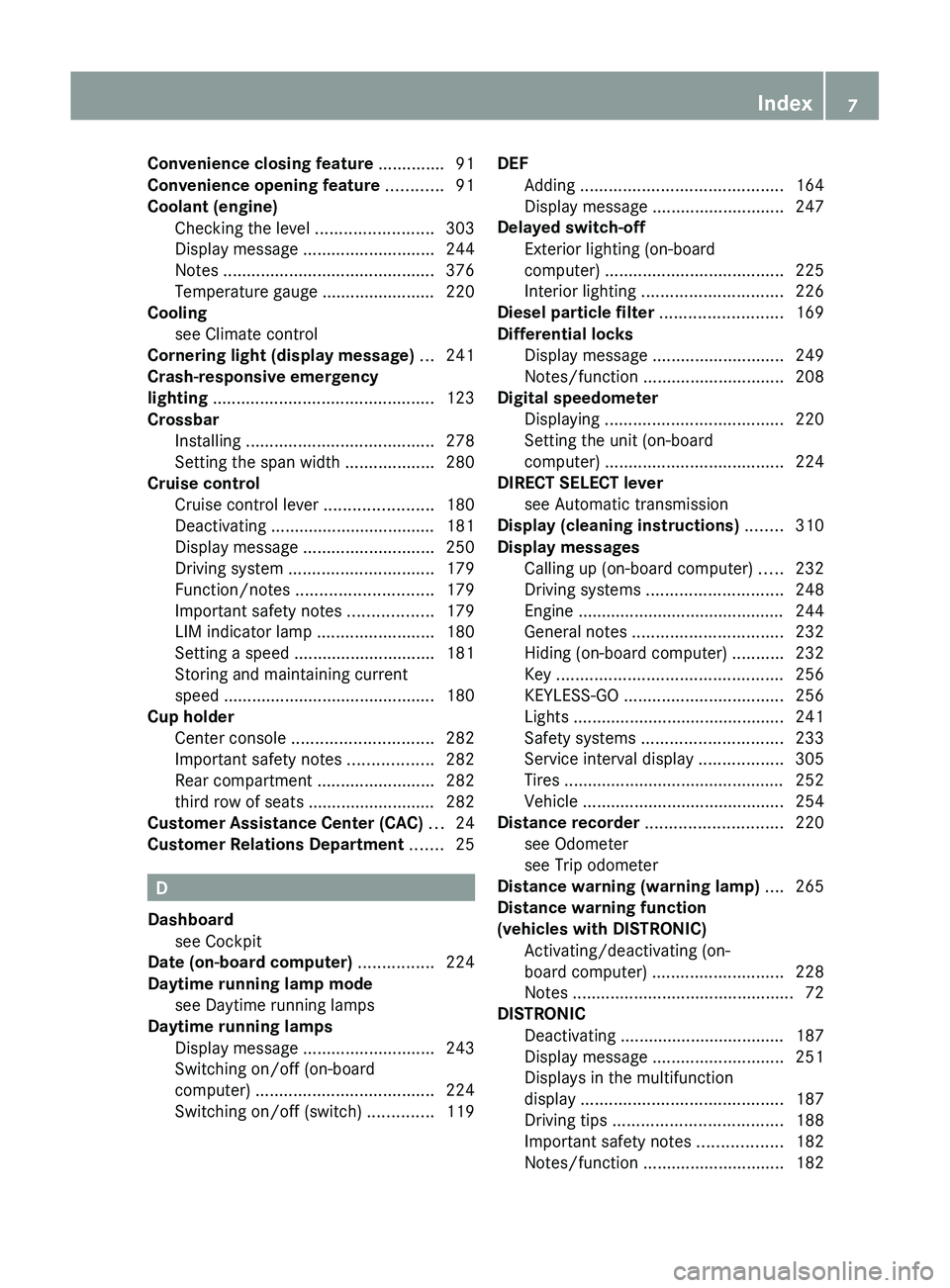
Convenience closing feature .............. 91
Convenience opening feature ............ 91
Coolant (engine) Checking the level .........................303
Display message ............................ 244
Notes ............................................. 376
Temperature gauge ........................ 220
Cooling
see Climate control
Cornering light (display message) ... 241
Crash-responsive emergency
lighting ............................................... 123
Crossbar Installing ........................................ 278
Setting the span width ...................280
Cruise control
Cruise control lever .......................180
Deactivating ................................... 181
Display message ............................ 250
Driving system ............................... 179
Function/notes ............................. 179
Important safety notes ..................179
LIM indicator lamp .........................180
Setting a speed .............................. 181
Storing and maintaining current
speed ............................................. 180
Cup holder
Center console .............................. 282
Important safety notes ..................282
Rear compartment .........................282
third row of seats ........................... 282
Customer Assistance Center (CAC) ... 24
Customer Relations Department ....... 25
D
Dashboard see Cockpit
Date (on-board computer) ................ 224
Daytime running lamp mode see Daytime running lamps
Daytime running lamps
Display message ............................ 243
Switching on/off (on-board
computer) ...................................... 224
Switching on/off (switch) ..............119
DEF
Adding ........................................... 164
Display message ............................ 247
Delayed switch-off
Exterior lighting (on-board
computer) ...................................... 225
Interior lighting .............................. 226
Diesel particle filter .......................... 169
Differential locks Display message ............................ 249
Notes/function .............................. 208
Digital speedometer
Displaying ...................................... 220
Setting the unit (on-board
computer) ...................................... 224
DIRECT SELECT lever
see Automatic transmission
Display (cleaning instructions) ........ 310
Display messages Calling up (on-board computer) .....232
Driving systems ............................. 248
Engine ............................................ 244
General notes ................................ 232
Hiding (on-board computer) ...........232
Key ................................................ 256
KEYLESS-GO .................................. 256
Lights ............................................. 241
Safety systems .............................. 233
Service interval display ..................305
Tires ............................................... 252
Vehicle ........................................... 254
Distance recorder ............................. 220
see Odometer
see Trip odometer
Distance warning (warning lamp) .... 265
Distance warning function
(vehicles with DISTRONIC) Activating/deactivating (on-
board computer) ............................ 228
Notes ............................................... 72
DISTRONIC
Deactivating ................................... 187
Display message ............................ 251
Displays in the multifunction
display ........................................... 187
Driving tips .................................... 188
Important safety notes ..................182
Notes/function .............................. 182Index7
Page 11 of 384
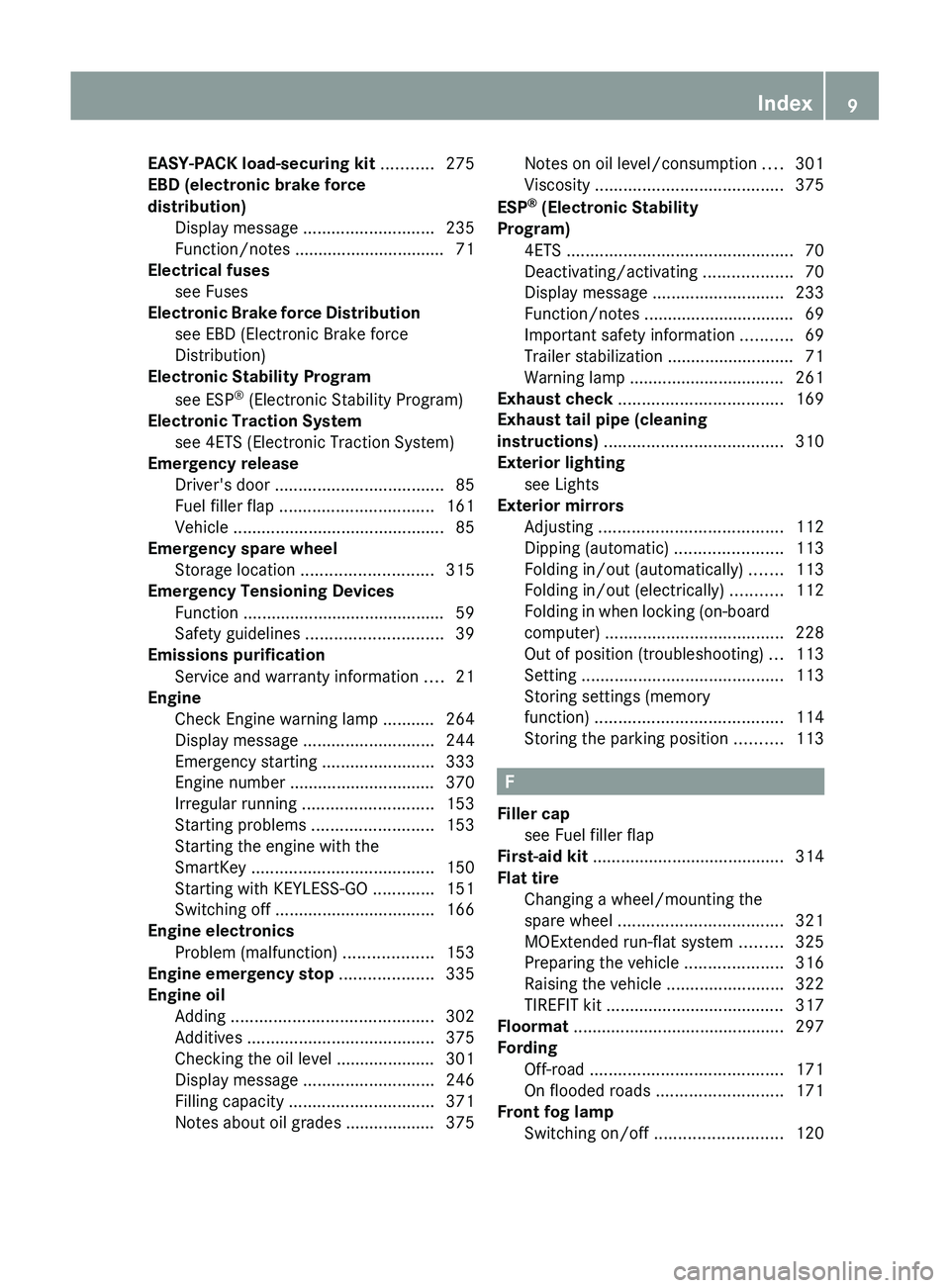
EASY-PACK load-securing kit ........... 275
EBD (electronic brake force
distribution) Display message ............................ 235
Function/notes ................................ 71
Electrical fuses
see Fuses
Electronic Brake force Distribution
see EBD (Electronic Brake force
Distribution)
Electronic Stability Program
see ESP ®
(Electronic Stability Program)
Electronic Traction System
see 4ETS (Electronic Traction System)
Emergency release
Driver's door .................................... 85
Fuel filler flap ................................. 161
Vehicle ............................................. 85
Emergency spare wheel
Storage location ............................ 315
Emergency Tensioning Devices
Function ........................................... 59
Safety guidelines ............................. 39
Emissions purification
Service and warranty information ....21
Engine
Check Engine warning lamp ........... 264
Display message ............................ 244
Emergency starting ........................333
Engine number ............................... 370
Irregular running ............................ 153
Starting problems ..........................153
Starting the engine with the
SmartKey ....................................... 150
Starting with KEYLESS-GO .............151
Switching off .................................. 166
Engine electronics
Problem (malfunction) ...................153
Engine emergency stop .................... 335
Engine oil Adding ........................................... 302
Additives ........................................ 375
Checking the oil level ..................... 301
Display message ............................ 246
Filling capacity ............................... 371
Notes about oil grades ................... 375Notes on oil level/consumption ....301
Viscosity ........................................ 375
ESP ®
(Electronic Stability
Program) 4ETS ................................................ 70
Deactivating/activating ...................70
Display message ............................ 233
Function/notes ................................ 69
Important safety information ...........69
Trailer stabilization ........................... 71
Warning lamp ................................. 261
Exhaust check ................................... 169
Exhaust tail pipe (cleaning
instructions) ...................................... 310
Exterior lighting see Lights
Exterior mirrors
Adjusting ....................................... 112
Dipping (automatic) .......................113
Folding in/out (automatically) .......113
Folding in/out (electrically) ...........112
Folding in when locking (on-board
computer) ...................................... 228
Out of position (troubleshooting) ...113
Setting ........................................... 113
Storing settings (memory
function) ........................................ 114
Storing the parking position ..........113
F
Filler cap see Fuel filler flap
First-aid kit ......................................... 314
Flat tire Changing a wheel/mounting the
spare wheel ................................... 321
MOExtended run-flat system .........325
Preparing the vehicle .....................316
Raising the vehicle .........................322
TIREFIT kit ...................................... 317
Floormat ............................................. 297
Fording Off-road ......................................... 171
On flooded roads ........................... 171
Front fog lamp
Switching on/off ........................... 120
Index9
Page 15 of 384
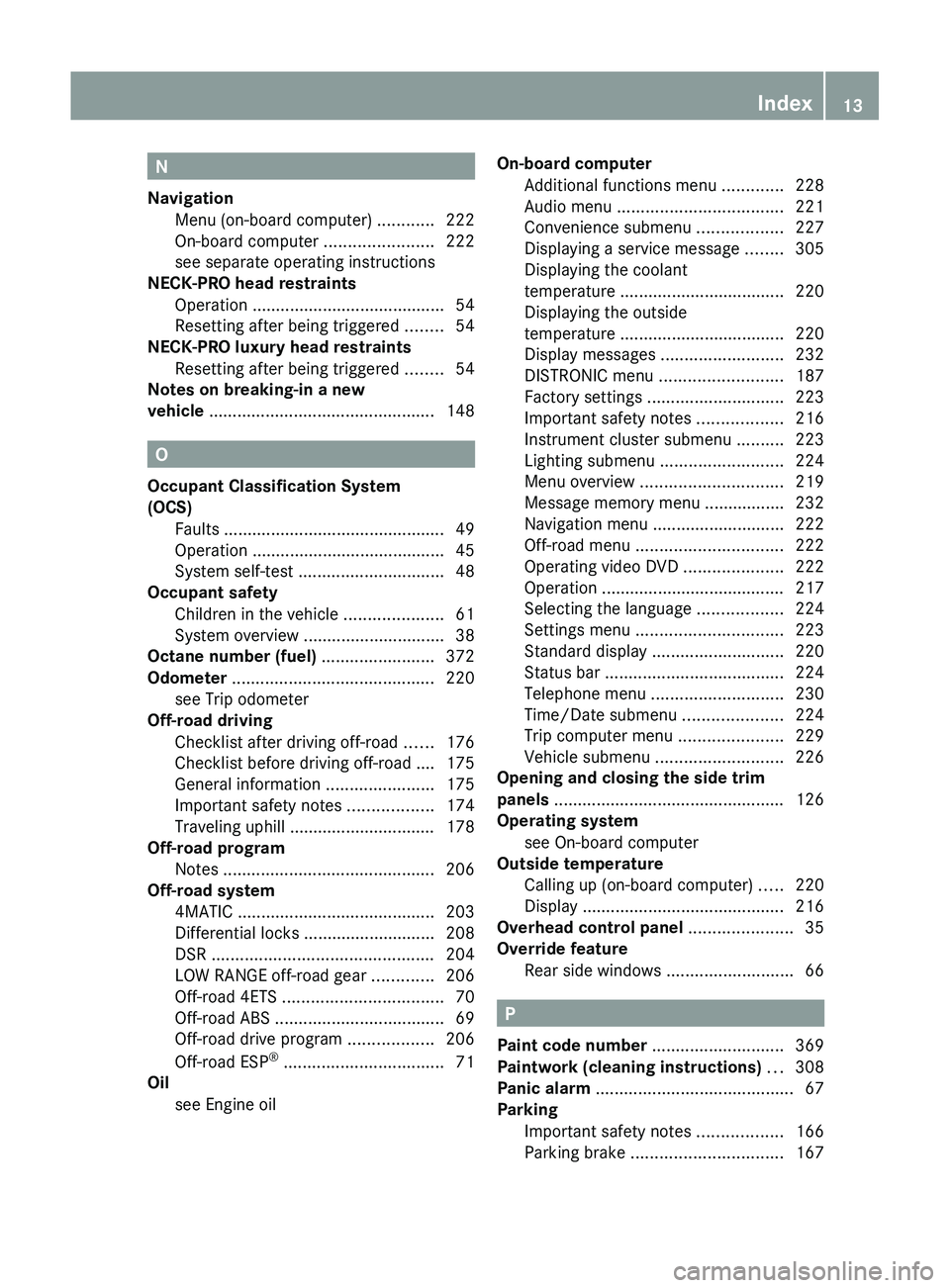
N
Navigation Menu (on-board computer) ............222
On-board computer .......................222
see separate operating instructions
NECK-PRO head restraints
Operation ......................................... 54
Resetting after being triggered ........54
NECK-PRO luxury head restraints
Resetting after being triggered ........54
Notes on breaking-in a new
vehicle ................................................ 148
O
Occupant Classification System
(OCS) Faults ............................................... 49
Operation ......................................... 45
System self-test ............................... 48
Occupant safety
Children in the vehicle .....................61
System overview .............................. 38
Octane number (fuel) ........................ 372
Odometer ........................................... 220
see Trip odometer
Off-road driving
Checklist after driving off-road ......176
Checklist before driving off-road .... 175
General information .......................175
Important safety notes ..................174
Traveling uphill ............................... 178
Off-road program
Notes ............................................. 206
Off-road system
4MATIC .......................................... 203
Differential locks ............................ 208
DSR ............................................... 204
LOW RANGE off-road gear .............206
Off-road 4ETS .................................. 70
Off-road ABS .................................... 69
Off-road drive program ..................206
Off-road ESP ®
.................................. 71
Oil
see Engine oil
On-board computer
Additional functions menu .............228
Audio menu ................................... 221
Convenience submenu ..................227
Displaying a service message ........305
Displaying the coolant
temperature ................................... 220
Displaying the outside
temperature ................................... 220
Display messages ..........................232
DISTRONIC menu .......................... 187
Factory settings ............................. 223
Important safety notes ..................216
Instrument cluster submenu ..........223
Lighting submenu .......................... 224
Menu overview .............................. 219
Message memory menu ................. 232
Navigation menu ............................ 222
Off-road menu ............................... 222
Operating video DVD .....................222
Operation ....................................... 217
Selecting the language ..................224
Settings menu ............................... 223
Standard display ............................ 220
Status bar ...................................... 224
Telephone menu ............................ 230
Time/Date submenu .....................224
Trip computer menu ......................229
Vehicle submenu ........................... 226
Opening and closing the side trim
panels ................................................. 126
Operating system see On-board computer
Outside temperature
Calling up (on-board computer) .....220
Display ........................................... 216
Overhead control panel ...................... 35
Override feature Rear side windows ...........................66
P
Paint code number ............................ 369
Paintwork (cleaning instructions) ... 308
Panic alarm .......................................... 67
Parking Important safety notes ..................166
Parking brake ................................ 167
Index13
Page 18 of 384
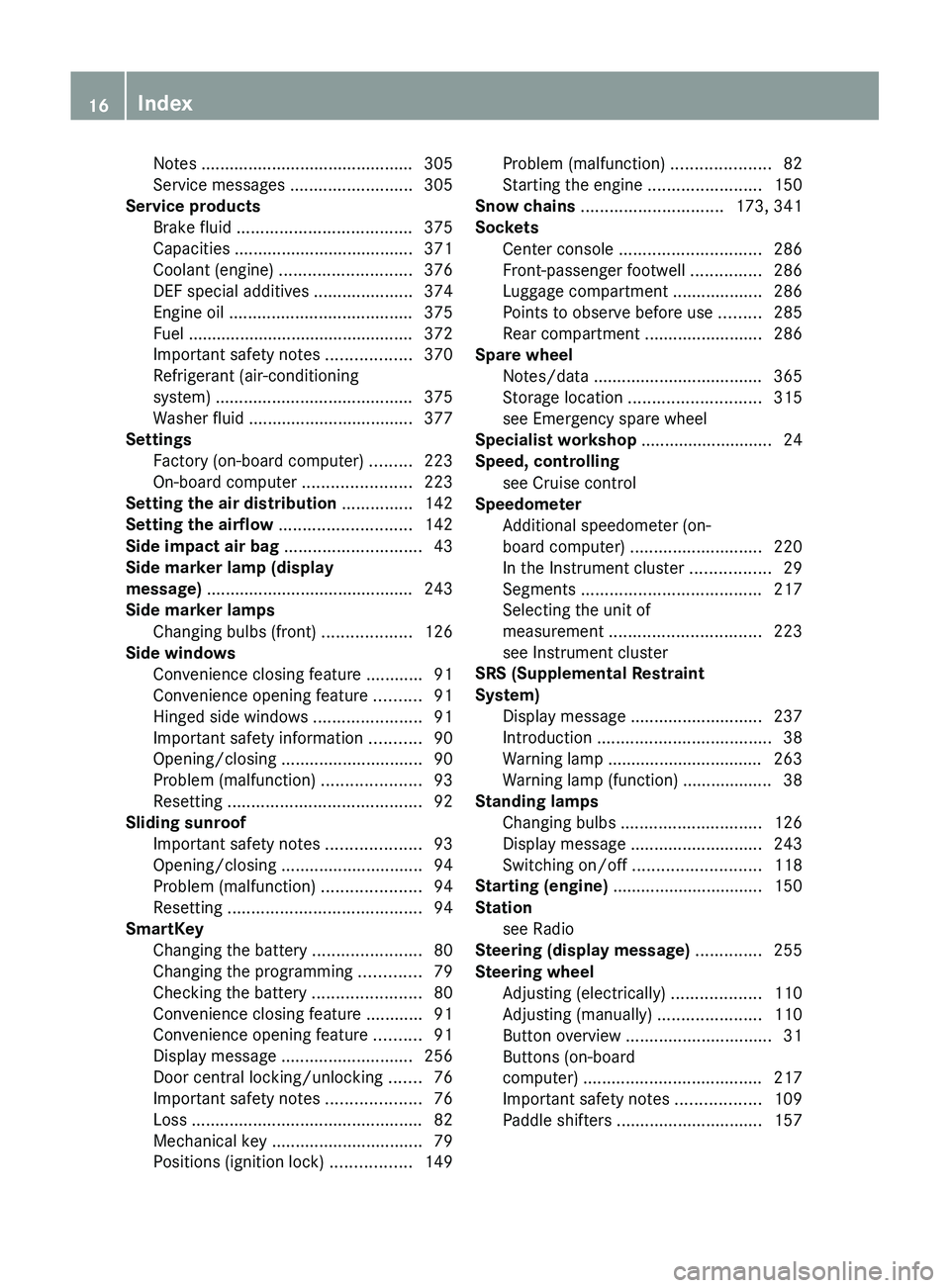
Notes ............................................. 305
Service messages ..........................305
Service products
Brake fluid ..................................... 375
Capacities ...................................... 371
Coolant (engine) ............................ 376
DEF special additives .....................374
Engine oil ....................................... 375
Fuel ................................................ 372
Important safety notes ..................370
Refrigerant (air-conditioning
system) .......................................... 375
Washer fluid ................................... 377
Settings
Factory (on-board computer) .........223
On-board computer .......................223
Setting the air distribution ............... 142
Setting the airflow ............................ 142
Side impact air bag ............................. 43
Side marker lamp (display
message) ............................................ 243
Side marker lamps Changing bulbs (front) ...................126
Side windows
Convenience closing feature ............91
Convenience opening feature ..........91
Hinged side windows .......................91
Important safety information ...........90
Opening/closing .............................. 90
Problem (malfunction) .....................93
Resetting ......................................... 92
Sliding sunroof
Important safety notes ....................93
Opening/closing .............................. 94
Problem (malfunction) .....................94
Resetting ......................................... 94
SmartKey
Changing the battery .......................80
Changing the programming .............79
Checking the battery .......................80
Convenience closing feature ............91
Convenience opening feature ..........91
Display message ............................ 256
Door central locking/unlocking .......76
Important safety notes ....................76
Loss ................................................. 82
Mechanical key ................................ 79
Positions (ignition lock) .................149Problem (malfunction) .....................82
Starting the engine ........................150
Snow chains .............................. 173, 341
Sockets Center console .............................. 286
Front-passenger footwell ...............286
Luggage compartment ...................286
Points to observe before use .........285
Rear compartment .........................286
Spare wheel
Notes/data .................................... 365
Storage location ............................ 315
see Emergency spare wheel
Specialist workshop ............................ 24
Speed, controlling see Cruise control
Speedometer
Additional speedometer (on-
board computer) ............................ 220
In the Instrument cluster .................29
Segments ...................................... 217
Selecting the unit of
measurement ................................ 223
see Instrument cluster
SRS (Supplemental Restraint
System) Display message ............................ 237
Introduction ..................................... 38
Warning lamp ................................. 263
Warning lamp (function) ................... 38
Standing lamps
Changing bulbs .............................. 126
Display message ............................ 243
Switching on/off ........................... 118
Starting (engine) ................................ 150
Station see Radio
Steering (display message) .............. 255
Steering wheel Adjusting (electrically) ...................110
Adjusting (manually) ......................110
Button overview ............................... 31
Buttons (on-board
computer) ...................................... 217
Important safety notes ..................109
Paddle shifters ............................... 15716Index
Page 22 of 384
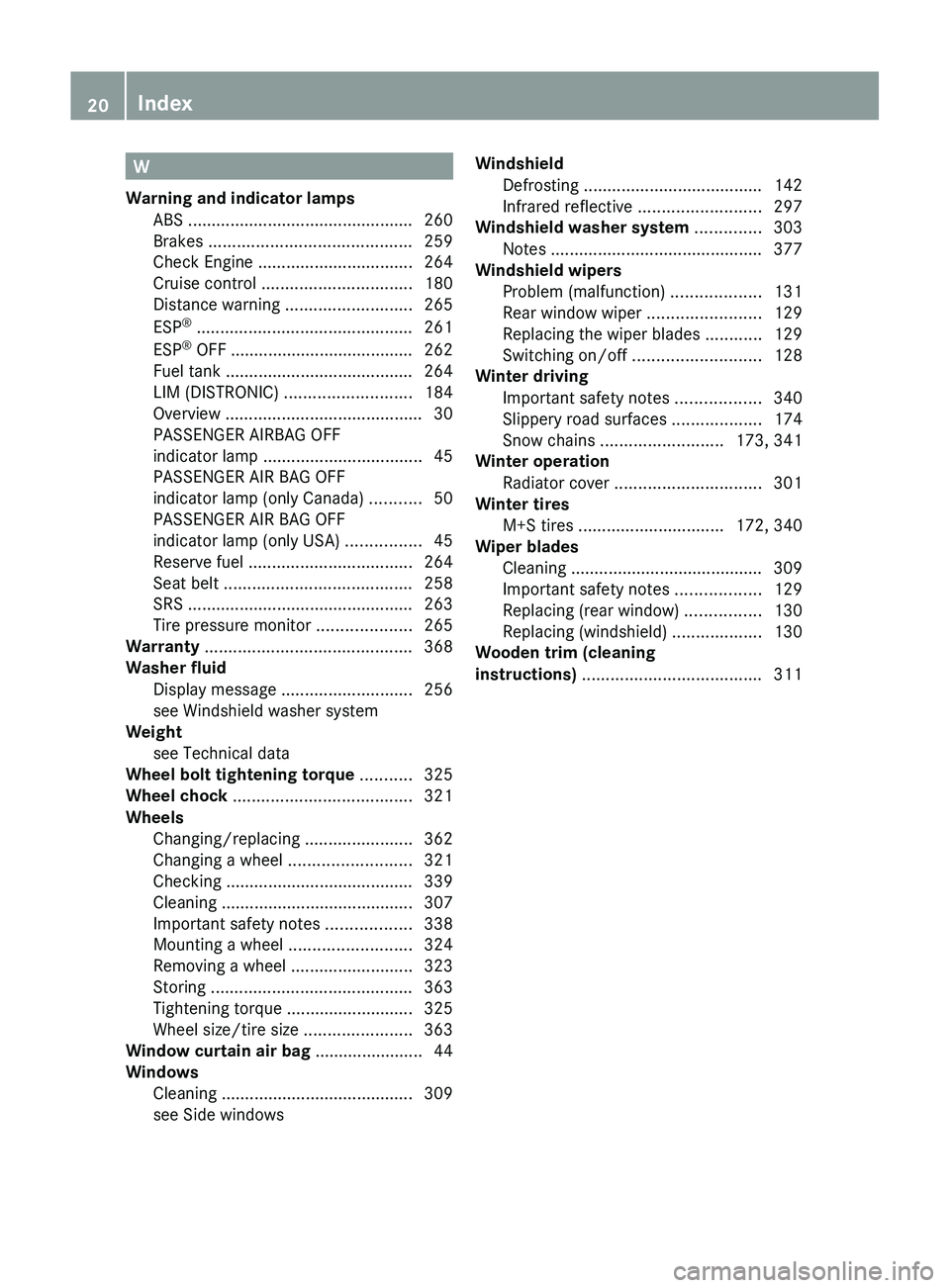
W
Warning and indicator lamps ABS ................................................ 260
Brakes ........................................... 259
Check Engine ................................. 264
Cruise control ................................ 180
Distance warning ........................... 265
ESP ®
.............................................. 261
ESP ®
OFF ....................................... 262
Fuel tank ........................................ 264
LIM (DISTRONIC) ........................... 184
Overview .......................................... 30
PASSENGER AIRBAG OFF
indicator lamp .................................. 45
PASSENGER AIR BAG OFF
indicator lamp (only Canada) ...........50
PASSENGER AIR BAG OFF
indicator lamp (only USA) ................45
Reserve fuel ................................... 264
Seat belt ........................................ 258
SRS ................................................ 263
Tire pressure monitor ....................265
Warranty ............................................ 368
Washer fluid Display message ............................ 256
see Windshield washer system
Weight
see Technical data
Wheel bolt tightening torque ........... 325
Wheel chock ...................................... 321
Wheels Changing/replacing .......................362
Changing a wheel .......................... 321
Checking ........................................ 339
Cleaning ......................................... 307
Important safety notes ..................338
Mounting a wheel .......................... 324
Removing a wheel ..........................323
Storing ........................................... 363
Tightening torque ........................... 325
Wheel size/tire size .......................363
Window curtain air bag ....................... 44
Windows Cleaning ......................................... 309
see Side windows Windshield
Defrosting ...................................... 142
Infrared reflective .......................... 297
Windshield washer system .............. 303
Notes ............................................. 377
Windshield wipers
Problem (malfunction) ...................131
Rear window wiper ........................129
Replacing the wiper blades ............129
Switching on/off ........................... 128
Winter driving
Important safety notes ..................340
Slippery road surfaces ...................174
Snow chains .......................... 173, 341
Winter operation
Radiator cover ............................... 301
Winter tires
M+S tires ............................... 172, 340
Wiper blades
Cleaning ......................................... 309
Important safety notes ..................129
Replacing (rear window) ................130
Replacing (windshield) ...................130
Wooden trim (cleaning
instructions) ...................................... 31120Index
Page 32 of 384
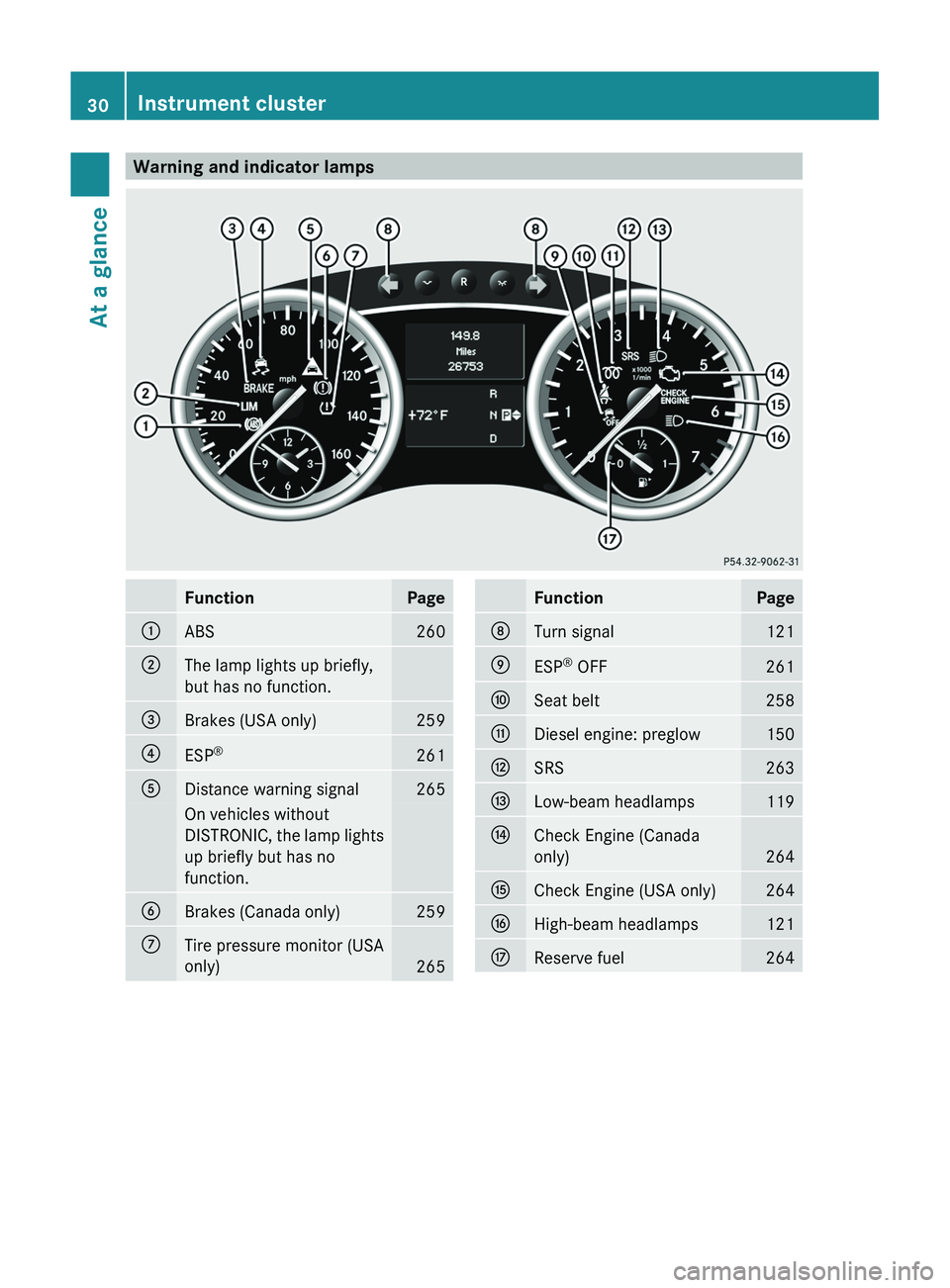
Warning and indicator lampsFunctionPage:ABS260;The lamp lights up briefly,
but has no function.=Brakes (USA only)259?ESP ®261ADistance warning signal265On vehicles without
DISTRONIC, the lamp lights
up briefly but has no
function.BBrakes (Canada only)259CTire pressure monitor (USA
only)
265
FunctionPageDTurn signal121EESP ®
OFF261FSeat belt258GDiesel engine: preglow150HSRS263ILow-beam headlamps119JCheck Engine (Canada
only)
264
KCheck Engine (USA only)264LHigh-beam headlamps121MReserve fuel26430Instrument clusterAt a glance
Page 40 of 384
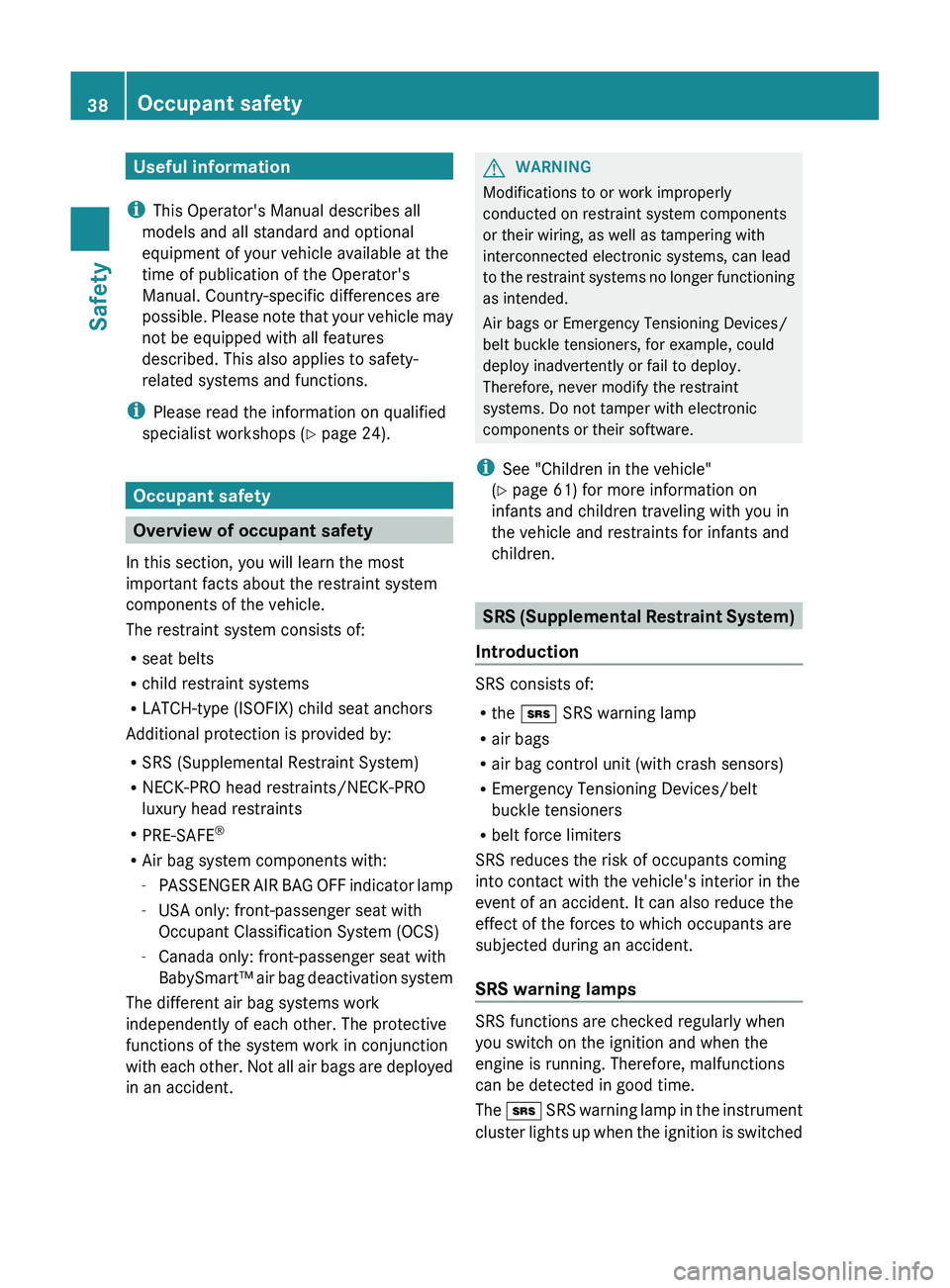
Useful information
i This Operator's Manual describes all
models and all standard and optional
equipment of your vehicle available at the
time of publication of the Operator's
Manual. Country-specific differences are
possible. Please note that your vehicle may
not be equipped with all features
described. This also applies to safety-
related systems and functions.
i Please read the information on qualified
specialist workshops ( Y page 24).
Occupant safety
Overview of occupant safety
In this section, you will learn the most
important facts about the restraint system
components of the vehicle.
The restraint system consists of:
R seat belts
R child restraint systems
R LATCH-type (ISOFIX) child seat anchors
Additional protection is provided by:
R SRS (Supplemental Restraint System)
R NECK-PRO head restraints/NECK-PRO
luxury head restraints
R PRE-SAFE ®
R Air bag system components with:
- PASSENGER AIR BAG OFF indicator lamp
- USA only: front-passenger seat with
Occupant Classification System (OCS)
- Canada only: front-passenger seat with
BabySmart™ air bag deactivation system
The different air bag systems work
independently of each other. The protective
functions of the system work in conjunction
with each other. Not all air bags are deployed
in an accident.
GWARNING
Modifications to or work improperly
conducted on restraint system components
or their wiring, as well as tampering with
interconnected electronic systems, can lead
to the restraint systems no longer functioning
as intended.
Air bags or Emergency Tensioning Devices/
belt buckle tensioners, for example, could
deploy inadvertently or fail to deploy.
Therefore, never modify the restraint
systems. Do not tamper with electronic
components or their software.
i See "Children in the vehicle"
( Y page 61) for more information on
infants and children traveling with you in
the vehicle and restraints for infants and
children.
SRS (Supplemental Restraint System)
Introduction
SRS consists of:
R the + SRS warning lamp
R air bags
R air bag control unit (with crash sensors)
R Emergency Tensioning Devices/belt
buckle tensioners
R belt force limiters
SRS reduces the risk of occupants coming
into contact with the vehicle's interior in the
event of an accident. It can also reduce the
effect of the forces to which occupants are
subjected during an accident.
SRS warning lamps
SRS functions are checked regularly when
you switch on the ignition and when the
engine is running. Therefore, malfunctions
can be detected in good time.
The + SRS warning lamp in the instrument
cluster lights up when the ignition is switched
38Occupant safetySafety
Page 41 of 384
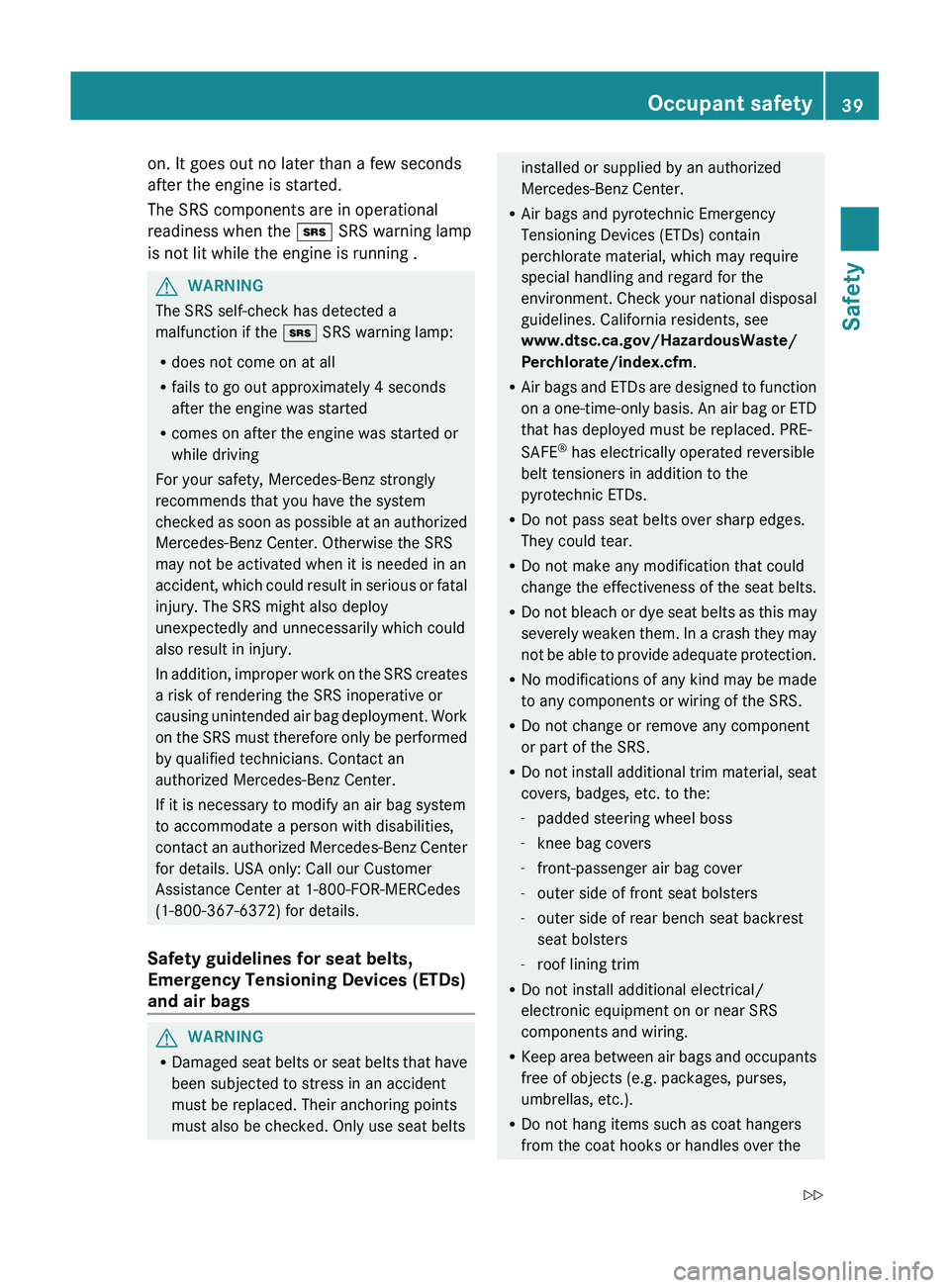
on. It goes out no later than a few seconds
after the engine is started.
The SRS components are in operational
readiness when the + SRS warning lamp
is not lit while the engine is running .GWARNING
The SRS self-check has detected a
malfunction if the + SRS warning lamp:
R does not come on at all
R fails to go out approximately 4 seconds
after the engine was started
R comes on after the engine was started or
while driving
For your safety, Mercedes-Benz strongly
recommends that you have the system
checked as soon as possible at an authorized
Mercedes-Benz Center. Otherwise the SRS
may not be activated when it is needed in an
accident, which could result in serious or fatal
injury. The SRS might also deploy
unexpectedly and unnecessarily which could
also result in injury.
In addition, improper work on the SRS creates
a risk of rendering the SRS inoperative or
causing unintended air bag deployment. Work
on the SRS must therefore only be performed
by qualified technicians. Contact an
authorized Mercedes-Benz Center.
If it is necessary to modify an air bag system
to accommodate a person with disabilities,
contact an authorized Mercedes-Benz Center
for details. USA only: Call our Customer
Assistance Center at 1-800-FOR-MERCedes
(1-800-367-6372) for details.
Safety guidelines for seat belts,
Emergency Tensioning Devices (ETDs)
and air bags
GWARNING
R Damaged seat belts or seat belts that have
been subjected to stress in an accident
must be replaced. Their anchoring points
must also be checked. Only use seat belts
installed or supplied by an authorized
Mercedes-Benz Center.
R Air bags and pyrotechnic Emergency
Tensioning Devices (ETDs) contain
perchlorate material, which may require
special handling and regard for the
environment. Check your national disposal
guidelines. California residents, see
www.dtsc.ca.gov/HazardousWaste/
Perchlorate/index.cfm .
R Air bags and ETDs are designed to function
on a one-time-only basis. An air bag or ETD
that has deployed must be replaced. PRE-
SAFE ®
has electrically operated reversible
belt tensioners in addition to the
pyrotechnic ETDs.
R Do not pass seat belts over sharp edges.
They could tear.
R Do not make any modification that could
change the effectiveness of the seat belts.
R Do not bleach or dye seat belts as this may
severely weaken them. In a crash they may
not be able to provide adequate protection.
R No modifications of any kind may be made
to any components or wiring of the SRS.
R Do not change or remove any component
or part of the SRS.
R Do not install additional trim material, seat
covers, badges, etc. to the:
- padded steering wheel boss
- knee bag covers
- front-passenger air bag cover
- outer side of front seat bolsters
- outer side of rear bench seat backrest
seat bolsters
- roof lining trim
R Do not install additional electrical/
electronic equipment on or near SRS
components and wiring.
R Keep area between air bags and occupants
free of objects (e.g. packages, purses,
umbrellas, etc.).
R Do not hang items such as coat hangers
from the coat hooks or handles over theOccupant safety39SafetyZ
Page 47 of 384
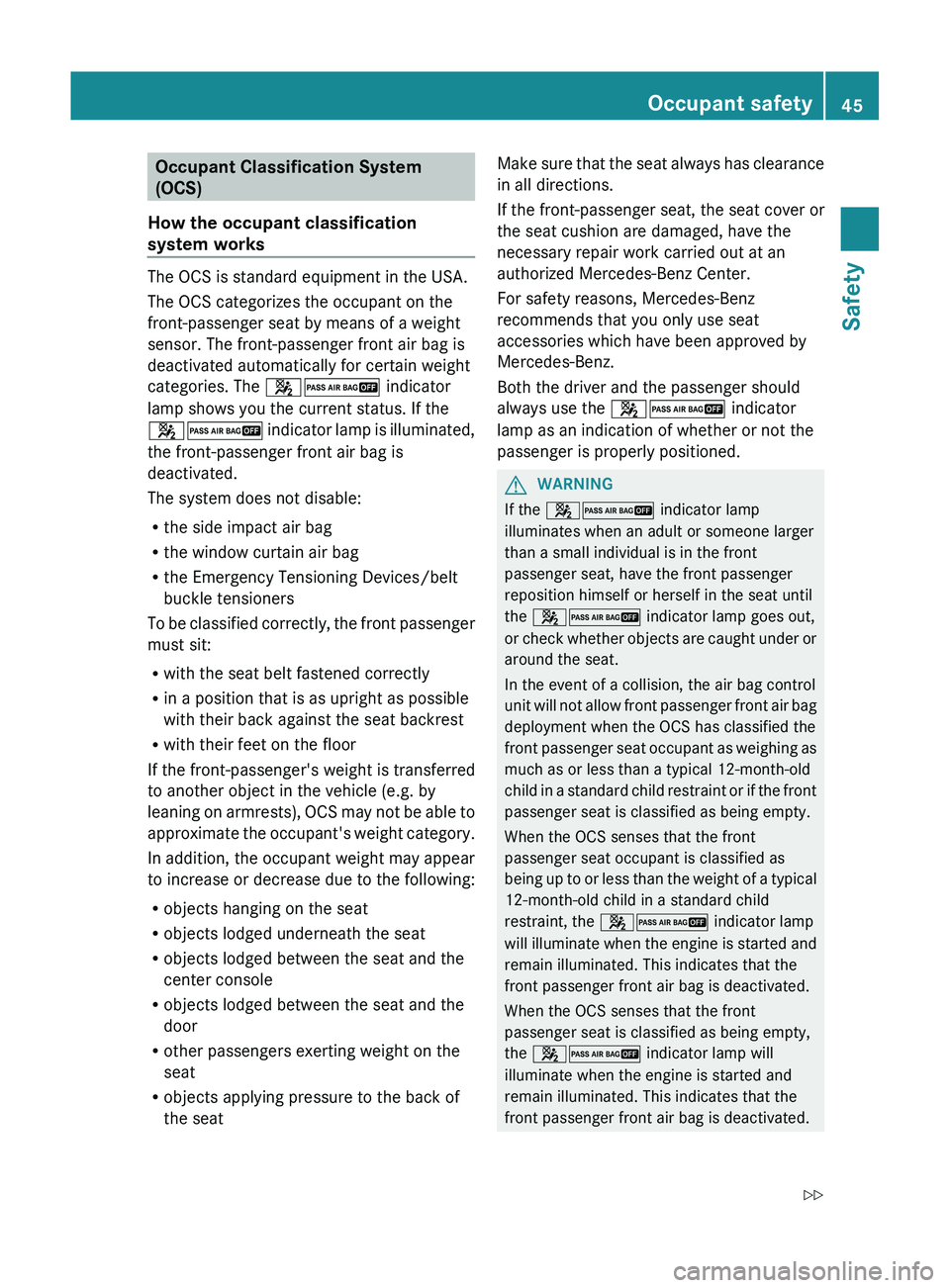
Occupant Classification System
(OCS)
How the occupant classification
system works
The OCS is standard equipment in the USA.
The OCS categorizes the occupant on the
front-passenger seat by means of a weight
sensor. The front-passenger front air bag is
deactivated automatically for certain weight
categories. The 42 indicator
lamp shows you the current status. If the
42 indicator lamp is illuminated,
the front-passenger front air bag is
deactivated.
The system does not disable:
R the side impact air bag
R the window curtain air bag
R the Emergency Tensioning Devices/belt
buckle tensioners
To be classified correctly, the front passenger
must sit:
R with the seat belt fastened correctly
R in a position that is as upright as possible
with their back against the seat backrest
R with their feet on the floor
If the front-passenger's weight is transferred
to another object in the vehicle (e.g. by
leaning on armrests), OCS may not be able to
approximate the occupant's weight category.
In addition, the occupant weight may appear
to increase or decrease due to the following:
R objects hanging on the seat
R objects lodged underneath the seat
R objects lodged between the seat and the
center console
R objects lodged between the seat and the
door
R other passengers exerting weight on the
seat
R objects applying pressure to the back of
the seat
Make sure that the seat always has clearance
in all directions.
If the front-passenger seat, the seat cover or
the seat cushion are damaged, have the
necessary repair work carried out at an
authorized Mercedes-Benz Center.
For safety reasons, Mercedes-Benz
recommends that you only use seat
accessories which have been approved by
Mercedes-Benz.
Both the driver and the passenger should
always use the 42 indicator
lamp as an indication of whether or not the
passenger is properly positioned.GWARNING
If the 42 indicator lamp
illuminates when an adult or someone larger
than a small individual is in the front
passenger seat, have the front passenger
reposition himself or herself in the seat until
the 42 indicator lamp goes out,
or check whether objects are caught under or
around the seat.
In the event of a collision, the air bag control
unit will not allow front passenger front air bag
deployment when the OCS has classified the
front passenger seat occupant as weighing as
much as or less than a typical 12-month-old
child in a standard child restraint or if the front
passenger seat is classified as being empty.
When the OCS senses that the front
passenger seat occupant is classified as
being up to or less than the weight of a typical
12-month-old child in a standard child
restraint, the 42 indicator lamp
will illuminate when the engine is started and
remain illuminated. This indicates that the
front passenger front air bag is deactivated.
When the OCS senses that the front
passenger seat is classified as being empty,
the 42 indicator lamp will
illuminate when the engine is started and
remain illuminated. This indicates that the
front passenger front air bag is deactivated.
Occupant safety45SafetyZ
Page 78 of 384

Useful information
i This Operator's Manual describes all
models and all standard and optional
equipment of your vehicle available at the
time of publication of the Operator's
Manual. Country-specific differences are
possible. Please note that your vehicle may
not be equipped with all features
described. This also applies to safety-
related systems and functions.
i Please read the information on qualified
specialist workshops ( Y page 24).
SmartKey
Important safety notes
GWARNING
When leaving the vehicle, always remove the
SmartKey from the ignition lock. Always take
the SmartKey with you and lock the vehicle.
Do not leave children unsupervised in the
vehicle, even if they are secured in a child
restraint system, and do not give them access
to an unlocked vehicle. A child's unsupervised
access to a vehicle could result in an accident
and/or serious personal injury. They could:
R injure themselves on vehicle parts
R be seriously or fatally injured by extreme
heat or cold
R injure themselves or have an accident with
vehicle equipment that may still be in
operation even after the SmartKey has
been removed from the ignition, such as the
seat adjustment, steering wheel
adjustment or memory function.
If children open a door, they could cause
severe or even fatal injury to other persons; if
they get out of the vehicle, they could injure
themselves when doing so or be seriously or
even fatally injured by any passing traffic.
Do not expose the child restraint system to
direct sunlight. The child restraint system's
metal parts, for example, could become very
hot, and a child could be burned on these
parts.GWARNING
If a key ring is too heavy or too large, the
weight acting on the key could cause it to turn
in the ignition lock or catch on the steering
wheel. This could cause the engine to be
switched off suddenly. You could lose control
of the vehicle and cause an accident. Do not
attach any heavy or large key rings to the key
that is inserted in the ignition.
General information
If you cannot lock or unlock the vehicle with
the SmartKey, either the battery in the
SmartKey is discharged, the SmartKey is
faulty or the starter battery is discharged.
XCheck the battery in the SmartKey and
replace it if necessary ( Y page 80).XUnlock the driver's door using the
mechanical key ( Y page 85).XLock the vehicle ( Y page 85).XHave the starter battery and battery
contacts checked at an authorized
Mercedes-Benz Center.
If the SmartKey is faulty, contact Roadside
Assistance or an authorized Mercedes-Benz
Center.
SmartKey functions
General notes
i USA only:
This device complies with Part 15 of the
FCC Rules. Operation is subject to the
following two conditions:
1. This device may not cause harmful
interference, and
2. this device must accept any interference
received, including interference that may
cause undesired operation.
76SmartKeyOpening/closing